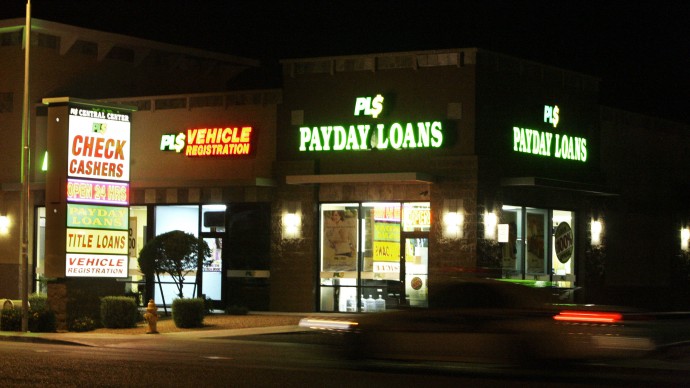
There are many reasons people don’t have bank accounts. For one thing, check-cashing stores can actually be cheaper than fees on everything. But some of these customers also use such “non-bank lenders” for a “payday loan,” or a two-week advance on their next paycheck.
In the early 1990s, 36 states bowed to lobbying pressure and authorized small loans using the borrower’s next paycheck as collateral. These now average $375 each and are used by 12 million people annually, according to a study by the Pew Charitable Trusts.
Another recent study shows that people who do this have to take out another loan the next month to pay off the first. This cycle can continue for months, with 62 percent eventually doing this for seven consecutive months or more — the point where the interest payment exceeds the loan amount.
The Consumer Financial Protection Bureau (CFPB) released their study of the industry on March 25, and the findings are more than a bit shocking. They followed “loan sequencing,” or how many times a payday loan is rolled over before it is finally repaid. The researchers don’t include interest rates, since interest rates vary widely, but with fees and interest, they estimate that a seven-month rollover on a loan is about 100 percent of the original value — suggesting a net annual rate of just under 200 percent.
The payday loan industry is organized and unapologetic. On the website of the Payday Business Owners Association, there’s a biweekly newsletter full of interesting links and fun facts. There’s also a great app for looking up the “un-banked percentage” in any target community and comparing it to the U.S. average of 7.7 percent. Visitors can also buy a chain of payday loan stores, if they’d like, and sample an impressive collection of scholarly studies on the industry.
But with profits like this, the loans can only be considered predatory. Clearly, it is a lucrative business, but with a default rate of 20 percent and many fees paid on the checks they handle, the operations do have their costs.
It’s unclear how much is made from payday loans, but for the borrowers, the results are very obvious. “This renewing of loans can put consumers on a slippery slope toward a debt trap in which they cannot get ahead of the money they owe,” CFPB Director Richard Cordray said.
Many payday borrowers live on fixed monthly incomes, such as retirees or disabled Americans receiving Social Security disability benefits. Of those payday borrowers receiving monthly payments, the study found that one out in five borrowed money every single month of the year.
“These kinds of stories are heartbreaking and they are happening all across the country,” Cordray said. “They demand that we pay serious attention to the human consequences of the payday loan market.
What can be done about this often predatory private industry? The industry newsletters show that many states, even rather conservative ones like Alabama and Idaho, are proposing new regulation on payday loans and so-called “un-banks.”
“We have to make sure regardless of what channel a borrower uses to take out a payday loan, there needs to be strong ability-to-repay standards,” said Tom Feltner, director of Financial Services at the Consumer Federation of America. The federation has called for that standard, which is typical of any other loan, to be applied to payday loans.
“Regardless of the term or structure of a payday loan, if back-to-back usage is frequent and lenders direct access to a bank account, borrowers are at risk. Ability to repay, not the ability to collect, should be the standard going forward,” Feltner added.
While regulation is clearly needed, those without a bank account are still vulnerable to one stiff blow destroying their financial life. But they still need access to credit.
Credit unions are expanding to meet the needs of the “un-banked.” The Federal Reserve Bank of St. Louis has been encouraging this, working with credit unions to expand in underserved communities. “The key advantage to consumers having bank accounts is avoiding costly alternative financial services and enabling families to build and protect their wealth,” the St. Louis branch of the Federal Reserve concluded in a report last year.
Pew Trusts recommends a number of reforms, the most important of which is requiring that loans made be over a six-month period with no penalty for early payoff. They called the current system “a market failure” and concluded, “Pew’s research conclusively shows that payday loans are unaffordable for most borrowers.” But this still means debt at the hands of the private market for those who can afford it least.
The most comprehensive proposal floated yet has been to allow the Post Office to expand into more financial services.
It’s not a radical idea at all. There was a Postal Savings System in place from 1910 to 1967, when it was abandoned due to unpopularity. It provided basic banking services for the very poor, but it did not offer loans. The latest proposal for a postal banking system would include “small loans” of an unspecified amount at a low rate of interest.
Sen. Elizabeth Warren (D-MA) is a strong backer of this system, seeing it as a chance to fix two problems at once — provide financial services without predation for the “un-banked” and have a new income stream to help keep the Postal Service solvent.
“If the Postal Service offered basic banking services—nothing fancy, just basic bill paying, check cashing and small-dollar loans—then it could provide affordable financial services for underserved families, and, at the same time, shore up its own financial footing,” she said of the recent proposal.
But such a system is unlikely to come soon, given its complexity.
Meanwhile, payday loans are being issued with high interest rates and a high tendency to rollover into debt that is at least as large as the original loan amount. Regulation and even wholesale change are urgently needed, and the pressure to do that is growing.

